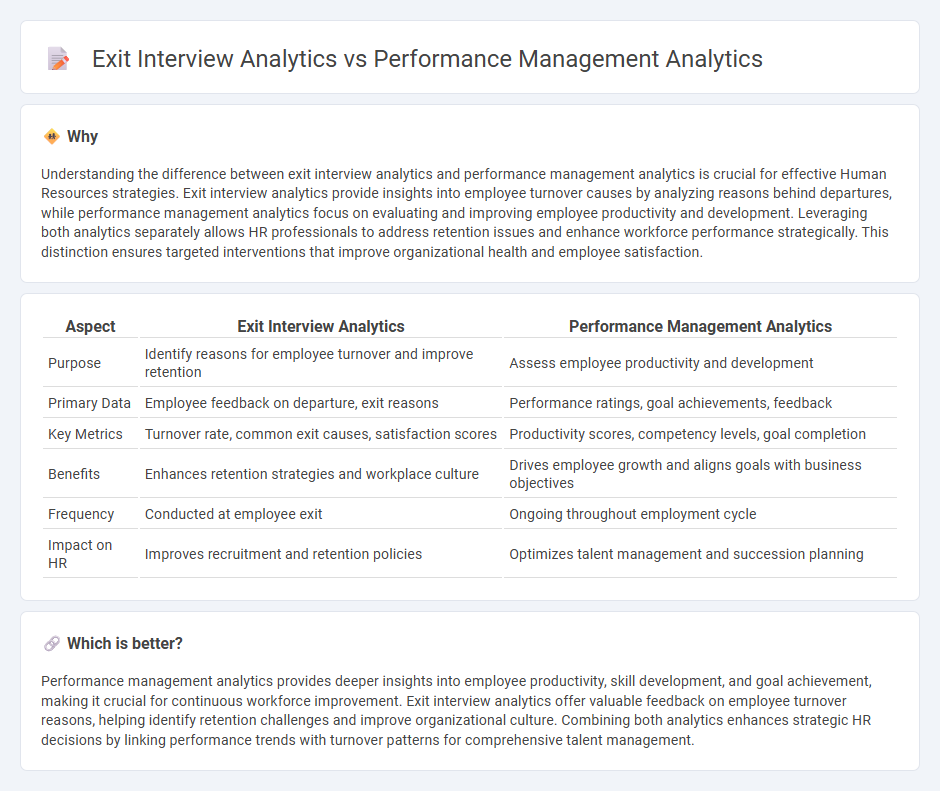
Exit interview analytics focus on collecting and analyzing data related to employee departures, identifying patterns in turnover reasons, and highlighting areas for organizational improvement. Performance management analytics evaluate employee productivity, goal achievement, and skill development to inform promotion decisions and training programs. Explore the differences between these analytics to enhance workforce strategy and retention.
Why it is important
Understanding the difference between exit interview analytics and performance management analytics is crucial for effective Human Resources strategies. Exit interview analytics provide insights into employee turnover causes by analyzing reasons behind departures, while performance management analytics focus on evaluating and improving employee productivity and development. Leveraging both analytics separately allows HR professionals to address retention issues and enhance workforce performance strategically. This distinction ensures targeted interventions that improve organizational health and employee satisfaction.
Comparison Table
| Aspect | Exit Interview Analytics | Performance Management Analytics |
|---|---|---|
| Purpose | Identify reasons for employee turnover and improve retention | Assess employee productivity and development |
| Primary Data | Employee feedback on departure, exit reasons | Performance ratings, goal achievements, feedback |
| Key Metrics | Turnover rate, common exit causes, satisfaction scores | Productivity scores, competency levels, goal completion |
| Benefits | Enhances retention strategies and workplace culture | Drives employee growth and aligns goals with business objectives |
| Frequency | Conducted at employee exit | Ongoing throughout employment cycle |
| Impact on HR | Improves recruitment and retention policies | Optimizes talent management and succession planning |
Which is better?
Performance management analytics provides deeper insights into employee productivity, skill development, and goal achievement, making it crucial for continuous workforce improvement. Exit interview analytics offer valuable feedback on employee turnover reasons, helping identify retention challenges and improve organizational culture. Combining both analytics enhances strategic HR decisions by linking performance trends with turnover patterns for comprehensive talent management.
Connection
Exit interview analytics provide critical insights into employee turnover patterns and reasons for departure, which directly influence performance management strategies by highlighting areas needing improvement. Analyzing data from exit interviews helps identify systemic issues affecting employee satisfaction and productivity, enabling HR to tailor performance management programs that address these challenges effectively. Integrating these analytics fosters a feedback loop that enhances talent retention and optimizes workforce performance.
Key Terms
**Performance Management Analytics:**
Performance Management Analytics centers on evaluating employee productivity, goal achievement, and skill development through real-time data and performance metrics. It leverages continuous feedback, competency assessments, and workforce trends to optimize talent management and enhance organizational outcomes. Discover how integrating advanced analytics transforms performance reviews into strategic growth tools.
Key Performance Indicators (KPIs)
Performance management analytics centers on tracking Key Performance Indicators (KPIs) such as employee productivity, goal achievement rates, and performance improvement over time to drive talent development and organizational growth. Exit interview analytics focuses on KPIs like employee satisfaction scores, turnover reasons, and retention risk factors to identify patterns leading to attrition. Explore the nuances of these analytics approaches to optimize workforce strategy and enhance business outcomes.
Continuous Feedback
Performance management analytics emphasize continuous feedback by regularly tracking employee performance metrics, engagement levels, and development needs to foster real-time improvements and goal alignment. Exit interview analytics concentrate on understanding reasons behind employee turnover through qualitative data, insights on workplace culture, and exit patterns, providing retrospective information crucial for long-term retention strategies. Explore how integrating continuous feedback mechanisms with exit analytics can drive proactive talent management and enhance organizational success.
 dowidth.com
dowidth.com